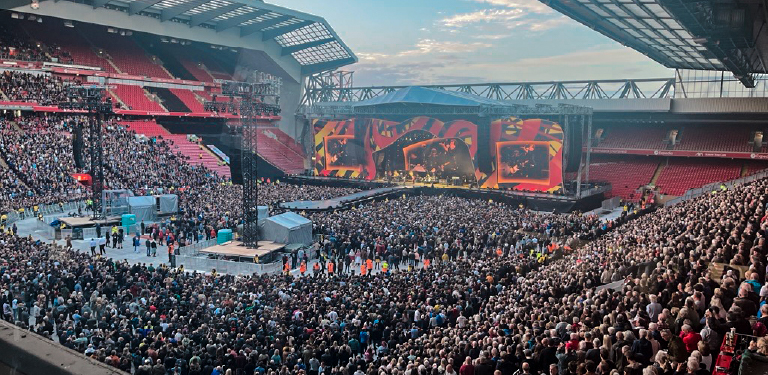
As the football season roars back into action, many of the UK’s biggest venues are once again transforming from concert arenas back to elite sporting stages.
Over the summer, these same grounds have hosted everything from chart-topping artists to major off-season events like boxing, keeping the turnstiles moving and revenue flowing. But whilst the stage lights and sound systems grabbed the headlines, it was the grounds teams who powered the show behind the scenes.
And the challenges? They’re as complex as the stage rigging.
“When I was at Coventry City, we had high-profile concerts most summers,” says Julien Morris, now a GMA Senior Regional Pitch Advisor. “We hosted the likes of Coldplay, Muse and Oasis. The ground staff would be there through all the concert build, keeping an absolute hawk eye on equipment and movements - especially when the flooring was laid, which was our biggest headache.”
It’s this kind of pressure that grounds staff across the UK are becoming increasingly familiar with. Concert organisers, third-party venue managers and club operations teams all have their role, but it’s the pitch teams who take on the responsibility of recovery, often with only a few weeks to prepare for pre-season fixtures.
“As a groundsperson, you always hoped the off-season events were done by the end of June,” Julien adds. “That would give you six weeks before potential pre-season fixtures. Again, that’s a revenue generator too. Clubs are often keen to get a game or two at home before the season starts.”
And it’s not just football. Whilst stadium concerts are often associated with places like Wembley Stadium and Anfield, cricket venues are no strangers to the live event circuit.
“In the Northwest, Lancashire County Cricket Club is one of the biggest concert venues,” says Ian Mather-Brewster, Cricket Key Account Manager at the GMA. “They have at least one concert or set of concerts every year - right in the middle of the cricket season.”
He points to the 2017 One Love Manchester concert as a clear example of the pressures grounds teams face. “That was a challenge for the ground staff because their concert period had finished but was extended by around seven days. They had a test match just few weeks later, televised live on Sky. The ground staff worked extremely hard to get the ground ready.”
For many venues, particularly those juggling sport and entertainment, surface choice plays a pivotal role. “The true multi-event venues will have systems that allow for rapid transitions,” says Tom Rowley, Football Key Account Manager at the GMA and former groundsperson at Leicester City FC.
“We’ve seen more ‘lay and play’ hybrid carpet systems recently. These types of system are a great option for stadia that requires a quick turnaround between events and sporting fixtures as they can be managed to the nth degree for a finite amount of time, then taken out and replaced. Wembley, Tottenham Hotspur, Real Madrid, these kinds of systems are crucial for venues with packed summer schedules. Stade de France famously had a concert just 7 days before the Champions League final back in 2022.”
The average in-stadia pitch renovation window is six to eight weeks growth from seed. By installing a hybrid carpet system, clubs can reduce this window to three to four weeks, providing a bigger window of opportunity for close-season activity, including concerts, major events, play-on-pitch opportunities and pre-season friendlies.
Unlike other sports turf, a hybrid carpet is grown off-site on specially prepared turf nursery field plots designed to provide the best possible growing conditions, including improved air flow and natural sunlight. From establishment to harvesting, some clubs like Liverpool FC and Manchester City have had their team of ground staff off-site tend to the pitch.
The beauty of a hybrid carpet system is it can be laid relatively quickly, approximately 2-4 days, allowing clubs the largest possible window for commercial activity on the pitch. Within days of installation, the hope is that roots will start to develop through the backing of the carpet and turf to form a reinforced natural playing surface. One of the positive things about a system like this, is it gives grounds staff the ability to evaluate the playing surface each year and make any adjustments if needed after the close-season period to ensure the best possible playing surface.
Tom also notes that working with external contractors for this type of surface is key and, again, often unnoticed. “The ground staff work really closely with companies who are farming that surface. It has to be seamless, quite literally.”
Whilst the technology has evolved, the core challenges remain the same. Heavy rigging, unpredictable weather, tight turnarounds and last-minute changes test even the most experienced grounds teams. But as Julien points out, the work begins long before the first note is played.
“From the head groundsperson’s perspective, they would hope to be involved in most of the operational planning. A lot of these concerts are meticulously planned at least 12 months in advance, if not more. Yes, it’s demanding. Yes, you make a lot of sacrifices, but I've been very privileged to see some amazing acts up close and personal - you create memories that last a lifetime.”
Whether it’s a chart-topper at Wembley or a cricket classic in Manchester, one thing’s for sure: behind every flawless playing surface is a grounds team working tirelessly to make it happen. Centre stage, but often behind the scenes.
Image: LFC/Jennifer Carter
















